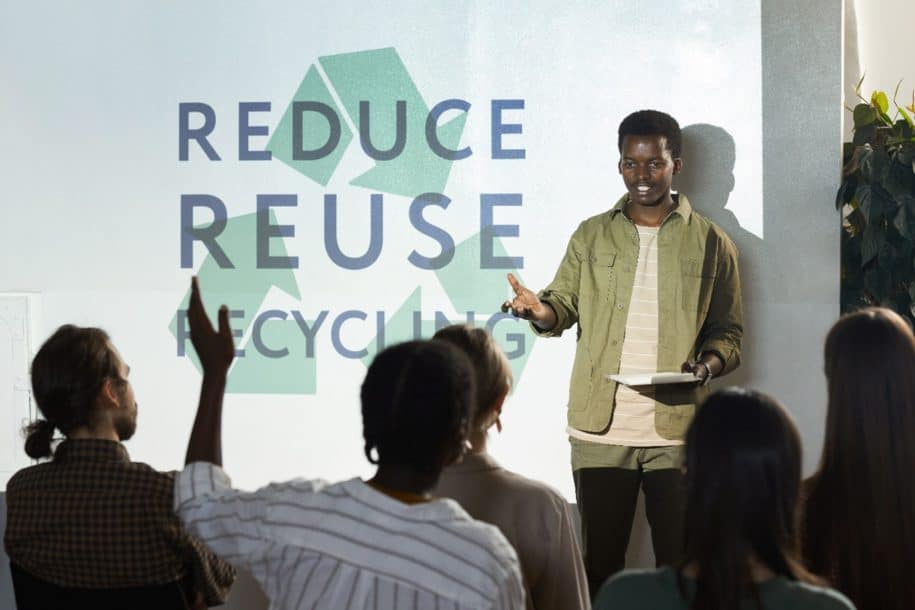We have previously explored the business case for zero waste—how investments in zero-waste programs enhance a business’ reputation and boost long-term profits. Once the motivation is there, how do we get such programs up and running? This article outlines the critical steps to achieving a successful zero waste business.
1. Initiate a Regular Waste Audit and Assessment System
Pinpointing and diligently recording waste streams is a must to initiate a zero waste program.
Manufacturing high-quality consumer products and providing excellent service to clients are activities that require input from multiple avenues. With various sources for input, it is difficult to ensure they are 100% efficient (all materials and resources contributing to the system are in the finished product). For example, in manufacturing, inefficiencies can show in the stockpiling of unwanted by-products (e.g., cloth scraps or defective products that do not make it to retailers). Within the service industry, this could mean reams of paper that end up in the trash can or disposable cups and stirrers in the pantry cupboard. By establishing baseline waste types and quantities, a business can identify waste diversion and reduction strategies. Employing comprehensive waste management software can improve the quality of these audits. Data gathered in these initial assessments helps businesses move forward with waste reduction programs by highlighting clear metrics and enabling the creation of sustainable waste-reduction targets.
2. Communicate Zero Waste Goals to Suppliers
Supplier commitment to efficiency with materials during the “use phase” enables businesses to focus on the processing side of zero waste programs.
Communicating zero waste goals with suppliers allows for a greater probability of finding alternative materials that deliver the same quality with little to no environmental impact (for instance, discovering materials with a longer shelf life, resulting in lower material losses during processing). The alignment of producer and supplier sustainability efforts also presents new opportunities for both parties to benefit from the best practices of the other. Understanding the full picture of a product’s life cycle reveals by-product and packaging wastes, allowing both businesses and suppliers to improve their respective zero-waste performance and boost long-term stability.
3. Engage Employees in Building a Culture of Sustainability
Employees will be the prime movers in successfully carrying out a zero-waste program.
Creating a system for advancing and monitoring proper waste segregation in the office requires environmental stewardship in the regular workday. Going paperless on routine office transactions and opting for electronic versions of manuals and other necessary documentation not only frees up storage space and makes it easier and quicker to access information when it is needed, but it is also one way to ease employees into the adoption of zero waste activities. Arranging seminars and dialogues with consulting experts displays to employees a willingness to invest in the environment and their continued education and training. As a best practice, training and certification management software can be utilized to monitor employee progress and pinpoint those aspects of a zero-waste training program that require attention. Management can also incentivize employees to brainstorm waste reduction ideas within their scope of work. Possible rewards for volunteered concepts promoting sustainability can include recognition (e.g., awards, shoutouts, experiences) and/or access to zero waste and sustainability workshops. By regularly engaging with employees and recognizing their suggestions, management expands its idea base and offers greater confidence to employees regarding the act of contributing.
Initiating a zero-waste program within a business takes an openness to enterprise examination. Locating the sources of waste in operations and identifying patterns will enable the formulation of possible waste reduction or diversion strategies. Tapping management software increases efficiency and minimizes errors in waste reporting. Additionally, discussing best practices with suppliers reveals more opportunities for ambitious waste reduction targets, assisting the establishment of a sustainability culture in individual organizations as well as the wider business community.
Author Bio
The SafetyStratus Research Advisory Group (RAG) brings together thought leaders from the global environmental, health, and safety community to promote best practices and provide key insights in the profession and the industries they serve. The Research Advisory Group also advocates, where practical, the intersection of and advances with the use of technology, such as the SafetyStratus enterprise EHS software platform. Group membership consists of representatives from across varied disciplines and market sectors as well as select members of the SafetyStratus team.
The primary objectives of the SafetyStratus RAG partnership are to:
- Build a strategic partnership between EHS practitioners and the SafetyStratus team.
- Provide engaging and practical content to the global EHS community.
- Provide discipline and market feedback specific to SafetyStratus products and services.
While the objectives of the RAG are varied, the primary public-facing outcome will be available through engaging and practical content found on the SafetyStratus resource pages. Various articles, papers, and other valuable resources will be produced and shared as part of an ongoing effort to cultivate a robust community. Ultimately, the SafetyStratus RAG will expand to have a broader reach and provide opportunities for more inclusion by all interested EHS professionals in a collaborative community environment.



